Here is one way that you can do what you want:
Define the thumb:

custom_thumb.xml
<shape
android:shape="rectangle">
<corners android:radius="20dp" />
<solid android:color="@android:color/holo_red_light" />
<size
android:width="40dp"
android:height="10dp" />
</shape>
Define the progress drawable for the seekbar:
seekbar_drawable.xml
<layer-list>
<item android:id="@android:id/progress">
<clip android:drawable="@android:color/transparent" />
</item>
</layer-list>
We will not show the progress for the seekbar, so we set the progress drawable to "transparent". Instead of the progress drawable, we will define another view that will show behind the progress bar. Why do we do this? It is because the seekbar wants to move the thumb outside the progress area and we want the thumb to remain entirely within the progress area. The second view encompasses all of the seekbar plus some area to the left and to the right to contain the thumb.
seekbar_background.xml
<shape>
<corners android:radius="20dp"/>
<solid android:color="@android:color/darker_gray" />
</shape>
Here is some sample XML to show how this looks:
<androidx.constraintlayout.widget.ConstraintLayout
android:layout_width="match_parent"
android:layout_height="match_parent"
android:background="@android:color/white">
<View
android:layout_width="0dp"
android:layout_height="0dp"
android:background="@drawable/seekbar_background"
app:layout_constraintBottom_toBottomOf="@id/seekBar"
app:layout_constraintEnd_toEndOf="@id/seekBar"
app:layout_constraintStart_toStartOf="@id/seekBar"
app:layout_constraintTop_toTopOf="@id/seekBar" />
<SeekBar
android:id="@+id/seekBar"
android:layout_width="200dp"
android:layout_height="wrap_content"
android:layout_marginBottom="16dp"
android:max="10000"
android:min="0"
android:paddingStart="20dp"
android:paddingEnd="20dp"
android:progressDrawable="@drawable/seekbar_drawable"
android:thumb="@drawable/custom_thumb"
app:layout_constraintBottom_toBottomOf="parent"
app:layout_constraintEnd_toEndOf="parent"
app:layout_constraintStart_toStartOf="parent"
app:layout_constraintTop_toTopOf="parent" />
</androidx.constraintlayout.widget.ConstraintLayout>

Use a SeekBar.OnSeekBarChangeListener to scroll the RecyclerView using the RecyclerView's scrolling functions. When the RecyclerView is scrolled manually, use a RecyclerView.OnScrollListener to set the seekbar's progress. You will have to establish the mapping of the two views scroll states.
I have hard-coded some values that you will probably need to adjust.
One can change the width of the thumb programmatically with the following code to adjust for number of Recyclerview items or to any other value.
To change the width of the thumb by a factor of two as an example, you can do the following:
val thumb = binding.seekBar.thumb as GradientDrawable
thumb.setSize(thumb.intrinsicWidth * 2, thumb.intrinsicHeight)



